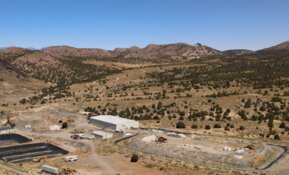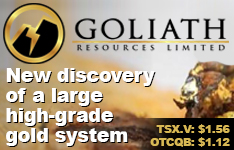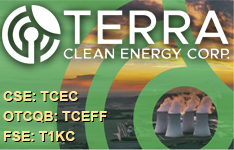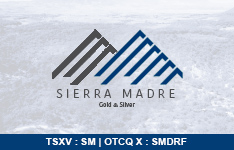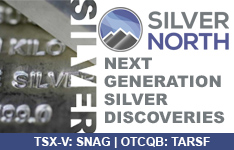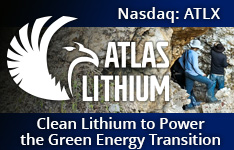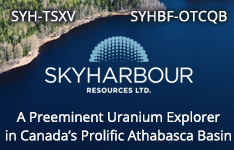Perpetua Resources Corp. (PPTA:TSX; PPTA:NASDAQ) has been awarded up to US$6.9 million in additional funding from the U.S. Army via the Defense Ordnance Technology Consortium (DOTC), bringing the company's total U.S. Department of Defense (DoD) funding to over US$80 million. The latest award supplements a previous US$15.5 million OTIA (Ordnance Technology Initiative Agreement) granted in August 2023, and is intended to expand ongoing pilot-scale testing at the company’s Stibnite Gold Project in Idaho. The Stibnite site is the only known domestic source of antimony trisulfide suitable for military specification (mil-spec) use.
According to Perpetua, the additional funding will be used to broaden the material sampling program and scale up the planned flexible, modular pilot plant for antimony processing. These efforts are designed to demonstrate the feasibility of a fully domestic supply chain for antimony trisulfide, a critical mineral used in more than 300 types of U.S. munitions and defense systems.
Jon Cherry, President and CEO of Perpetua Resources, stated in the news release, “Advancing America’s capabilities to process minerals critical to national defense is essential for our long-term mineral independence and resilience.”
“Though Perpetua received a Final Record of Decision in January 2025, its inclusion on the list demonstrates the [Trump] Administration's support for the project currently moving through the EXIM (Export-Import Bank of the United States) financing process. This is the critical path to a construction decision and integral to our investment thesis.” — ROTH Senior Research Analyst Mike Niehuser
The Stibnite Gold Project is expected to supply up to 35% of total U.S. antimony demand during its first six years of operations, based on estimates from the 2023 USGS commodity summary. The initiative has gained urgency since China, which controls the majority of the global antimony market, began restricting antimony exports to the United States in 2024.
Colonel Steven Power of the U.S. Army emphasized the strategic significance of the initiative, stating, “Establishing a fully domestic supply chain of this critical mineral is foundational to keeping America’s warfighters safe.”
Funding under the OTIA will be reimbursed on a cost-plus fixed fee basis, and the period of performance has been extended through the end of 2026. According to Perpetua, the total OTIA value now stands at up to US$22.4 million, subject to adjustment based on scope, budget, or programmatic changes.
Critical Mineral Spotlight: Antimony’s Strategic Rise
Antimony is increasingly recognized as a strategic mineral vital to both industrial and national security interests. As outlined in the Investing News Network's January write-up, its applications span a wide range of sectors, including defense, electronics, energy storage, and construction. Governments around the world - including the United States, Canada, the United Kingdom, Australia, and the European Union - have placed antimony on their official lists of critical minerals, acknowledging its essential role in technologies that support infrastructure resilience and defense readiness.
Historically, antimony was primarily used in flame retardants and lead-acid batteries. However, its utility has expanded with advances in clean energy and semiconductor manufacturing. Antimony trioxide, in particular, plays a key role in enhancing the fire resistance of consumer electronics, automotive parts, and textiles. Demand has been further supported by tighter building regulations aimed at mitigating climate-related fire risks.
Antimony's role in energy technology is also growing. It is a component in molten salt batteries, which offer high thermal stability and improved energy efficiency, making them attractive for grid-scale storage solutions. On the defense front, the mineral is used in a variety of systems, from ammunition and explosives to infrared devices and body armor. Analysts have noted that defense needs are now a primary driver of antimony demand, influencing global supply policies.
INN further explained how the supply chain has come under pressure due to geopolitical developments. In late 2024, China, the world’s largest producer of antimony, imposed an export ban following rising trade frictions with the United States. This move highlighted Western vulnerability and accelerated calls for domestic production capacity. Analysts at Katusa Research cautioned that shrinking reserves and tightening restrictions could trigger a supply crisis in North America and Europe.
In response, U.S. policymakers have moved to prioritize domestic antimony sources. A May 20 report from Fox News noted that a new mine in Idaho, which includes both gold and antimony production, received federal approval with the goal of enhancing national resource independence. The operation is expected to eventually meet up to one-third of domestic demand, according to Interior Secretary Doug Burgum.
Market analysts anticipate robust growth ahead. Straits Research projects the global antimony market will expand from US$2.62 billion in 2025 to US$4.83 billion by 2033, driven by rising demand across flame retardant manufacturing, defense alloys, and battery technologies. North America is forecasted to be the fastest-growing region, with policy support, permitting reforms, and military procurement contributing to accelerated development. The U.S. Department of the Interior’s designation of antimony under the FAST-41 permitting initiative underscores this momentum, ensuring faster approvals for domestic projects deemed critical to energy and national security goals.
Expert Commentary Signals Confidence in Perpetua’s Financing Path
In an April 23 research note, Mike Niehuser, managing director and senior research analyst at ROTH Capital Partners, reaffirmed a Buy rating on Perpetua Resources and maintained a US$19 target price. At the time of the report, the company was trading at approximately US$13.30, implying a potential return of 43%.
Niehuser highlighted that the Stibnite gold-antimony project was added to the U.S. Permitting Council’s list of strategic mineral projects under the March 2025 Executive Order on domestic critical mineral production. He wrote, “Though Perpetua received a Final Record of Decision in January 2025, its inclusion on the list demonstrates the [Trump] Administration's support for the project currently moving through the EXIM (Export-Import Bank of the United States) financing process.” He further stated, “This is the critical path to a construction decision and integral to our investment thesis.”
Niehuser noted that Perpetua was in the process of preparing its formal application to EXIM for debt financing. The company had previously received a non-binding letter of interest for up to US$1.8 billion, based on the 2020 feasibility study’s capital expenditure estimate. Since then, Perpetua’s Q1 2025 financial update revised the initial capital cost to US$2.215 billion, aligning with a likely increase in the financing request.
According to Niehuser, Perpetua’s federal support history strengthens its case for funding. He pointed to approximately US$75 million in cumulative awards from the U.S. Department of Defense for project development and permitting, which demonstrate long-standing federal interest. Regarding the permitting process, Niehuser emphasized the role of transparency and noted that projects like Stibnite were selected for the priority list to ensure efficient oversight and minimal external interference. “Transparency is important for the public to efficiently observe that the law is followed, without commercial or activist influence,” he wrote.
Niehuser concluded that the combination of federal recognition, pending Clean Water Act permitting, and anticipated EXIM financing positioned Perpetua for near-term advancement. “Inclusion on the Permitting Council’s initial list indicates federal support to grant the Clean Water Act 404 permit and for approval of EXIM financing, leading to a construction decision,” he commented.
In a May 23 report, Cantor Fitzgerald analyst Mike Kozak reaffirmed a positive outlook on Perpetua Resources Corp., maintaining a Buy rating and a target price of US$22 per share. At the time of publication, Perpetua’s share price was US$13.20, representing a potential return of 67%. According to Kozak, “This has a clear bias to the upside.”
Kozak reported that Perpetua had formally submitted its final application for US$2 billion in debt financing to the Export-Import Bank of the United States (EXIM) for construction of the Stibnite gold-antimony project in Idaho. He explained that although EXIM previously issued a letter of interest for US$1.8 billion, the updated request reflected changes outlined in Perpetua’s Q1 2025 financial update. That report estimated capital expenditures at US$2.2 billion, and the company’s application for US$2 billion would “mostly cover” the revised figure.
Perpetua was nearing the final stages of permitting at the time of the report, with only two minor state-level approvals remaining. Kozak noted that once secured, Stibnite would be considered “shovel ready.”
He also outlined EXIM’s anticipated timeline, stating that a “preliminary project letter” could be issued within 45 to 60 days, with financial close targeted for late 2025 or early 2026. Kozak’s analysis suggested strong alignment between the company’s development progress and the U.S. government’s priorities for critical mineral independence.
At the time of his report, Kozak noted that Perpetua had 71.5 million shares outstanding and a market capitalization of US$944 million.
Upcoming Developments: Building Momentum Toward a Strategic Resource
Perpetua’s May 2025 investor presentation outlines a clear path forward for the Stibnite Gold Project, identifying several near-term milestones that could significantly impact its development. The company received its final federal permit in May 2025, following the final Record of Decision in January 2025. Remaining ancillary permits, a formal construction decision, and project financing are expected later in the year, with operations targeted to commence in 2028.
The Stibnite Gold Project positions Perpetua as the operator of the only U.S. reserve of antimony and one of the largest, high-grade, open-pit gold projects in the country. Based on feasibility study and engineering data, the project is projected to deliver 463,000 ounces of gold annually in its first four years at an all-in sustaining cost (AISC) of US$435 per ounce. The project includes 148 million pounds of proven and probable antimony reserves and is designed to address legacy environmental damage through concurrent reclamation efforts.
The U.S. Export-Import Bank (EXIM) issued a non-binding letter of interest indicating potential financing of up to US$1.8 billion for the project. In total, Perpetua has been awarded up to US$75 million in critical minerals-related funding, including US$59.2 million under the Defense Production Act Title III and earlier awards through the DOTC and the Small Business Innovation Research (SBIR) program.
 Streetwise Ownership Overview*
Streetwise Ownership Overview*
Perpetua Resources Corp. (PPTA:TSX; PPTA:NASDAQ)
With antimony’s role in both national defense and clean energy applications, and with China and Russia together accounting for more than 70% of global supply, Perpetua’s Idaho-based initiative has gained increased attention from policymakers. The Stibnite project has been listed as a priority infrastructure project by the White House and included in the federal permitting dashboard.
Perpetua’s competitive positioning is further underscored by its low-cost hydroelectric power access, a favorable jurisdiction in Idaho, and a substantial gold-antimony resource base, creating a strategic foothold in North American mineral independence.
Ownership and Share Structure
According to Refinitiv, management and insiders own approximately 0.50% of Perpetua.
Institutions own about 63.52%. Top institutional shareholders include Paulson & Co. with 35.08%, Sun Valley Gold LLC with 4.2%, Sprott Asset Management LP with 4.16%, Kopernik Global Investors LLC with 3.05% and Sprott Asset Management USA Inc. with 3.41%. The rest is in retail.
Perpetua has 70.61 million (70.61M) outstanding shares and 69.97M free float traded shares. Its market cap is CA$937.13M. Its 52-week range is CA$6.80–CA$19.72 per share.
| Want to be the first to know about interesting Gold investment ideas? Sign up to receive the FREE Streetwise Reports' newsletter. | Subscribe |
Important Disclosures:
- Perpetua Resources Corp. is a billboard sponsor of Streetwise Reports and pays SWR a monthly sponsorship fee between US$4,000 and US$5,000.
- James Guttman wrote this article for Streetwise Reports LLC and provides services to Streetwise Reports as an employee.
- This article does not constitute investment advice and is not a solicitation for any investment. Streetwise Reports does not render general or specific investment advice and the information on Streetwise Reports should not be considered a recommendation to buy or sell any security. Each reader is encouraged to consult with his or her personal financial adviser and perform their own comprehensive investment research. By opening this page, each reader accepts and agrees to Streetwise Reports' terms of use and full legal disclaimer. Streetwise Reports does not endorse or recommend the business, products, services or securities of any company.
For additional disclosures, please click here.






